| | |
- "Kid, I've flown from one side of this galaxy to the other. I've seen a lot of strange stuff […]"
- ―Han Solo
The galaxy, as it was commonly referred to, was one of the trillions of galaxies in the universe. The galaxy was a vast composite of over 400 billion estimated stars[1] and over 3.2 million habitable systems[1] orbiting around a super-massive black hole at the heart of the galaxy.[6] The galactic arms rotated around this black hole across a diameter of over 100,000 light-years.[4] It was home to countless sentient species and star systems.
The galaxy would serve as the setting for trade, politics, and war throughout galactic history. In historical memory, the galaxy would see the successive eras of the Galactic Republic, Galactic Empire, New Republic, among others, and was home to the Force-using orders of the Jedi and Sith.[9]
Astrography
- "There's so many! Do they all have a system of planets?"
"Most of them." - ―Anakin Skywalker and Qui-Gon Jinn

A map of the galaxy showing the locations of various planets.
The galaxy had at least two companion galaxies,[3] one of which was known as the Rishi Maze.[10]
The galaxy was divided into several regions. The regions were subdivided into sectors, and then star systems. During the reign of the Galactic Empire, oversectors were created and were composed of several sectors ruled by a Grand Moff.[7] Notable sectors/autonomous regions included the Arkanis sector, Bothan Space, Centrality, Corporate Sector, Gordian Reach, Greater Javin, Hapes Consortium, Hutt Space, Mandalorian Space, Moddell sector, Senex-Juvex, Tion Cluster,[5] and Western Reaches.[8]
The Standard Galactic Grid was used to give the location of a galactic point in grid coordinates.[11] Areas of the galactic disk could be referred to as the galactic north, south, east and west.[12]
Notable points of interest were the 50 wonders of the Core, 30 wonders of the Mid Rim and the 25 wonders of the Outer Rim.[2]
Deep Core
The Deep Core served as the innermost and most brightly lit region of space. It was the most densely-packed with stars, nebulae, and other anomalies. As such, it was dangerous to navigate, leaving it relatively few explorers.[13] It was from here that the ancient, super-massive black hole bound the galaxy together.[6]
Core Worlds
The Core Worlds were home to the richest and most important worlds in the galaxy. Densely inhabited and located on the strategic ends of several major trade lanes, its planets were hubs of fashion, education, finance, and technology.[1] It is where the human species arguably[1] began.[14] It was from Coruscant, Corellia, Kuat, Hosnian Prime, and other systems that the fate of the galaxy was often decided.[13]
Colonies
The Colonies consisted of worlds colonized by the Core. Many of its planets sat along major trade routes, and were extremely wealthy. Notable planets included Abednedo,[13] Cato Neimoidia and Carida.[5]
Inner Rim
When first settled, the Inner Rim served as the frontier of galactic civilization for centuries, known simply as "the Rim." As colonization spread outwards, Inner Rim Worlds prospered. Notable planets included Bestine, Onderon, Thyferra, and Taanab.[5]
Expansion Region
The Expansion Region contained many newer colonies sponsored by their coreward neighbors. Notable planets included Umbara, Mimban,[13][5] and the mining station known as the Ring of Kafrene.[15]
Mid Rim
The Mid Rim was a tranquil region of space that brimmed with varied galactic worlds that boasted successful governments and thriving economies. Distance from the Core gave these worlds less fame or notoriety than planets closer to the galactic center.[13] The Mid Rim was unofficially considered the lawful extent of the Republic and the Galactic Empire.[6][1] Spillover piracy from the Outer Rim affected the region.[13] Those headed towards the Outer Rim saw it as the last taste of civilization, while those heading corewards saw it as the last grasp of frontier living.[16] Notable planets included Naboo, Malastare, Bothawui, Kashyyyk, Ruusan, Ringo Vinda, and Ord Mantell.[5]
Outer Rim Territories
The largest[13] region of the known galaxy, the Outer Rim Territories were considered to be lawless, strange, and savage. Criminal organizations, including the Hutt families of Hutt Space, the Black Sun, Pyke Syndicate, and Zygerrian slavers operated in abundance within the region.[1] Notable worlds included Arkanis, Mon Cala, Kessel, Ryloth, Eriadu, Sullust, Geonosis, Mustafar, Crait, Nal Hutta, Cantonica, Hoth, Lothal, Dagobah, Endor, Nar Shaddaa, Florrum, Yavin 4, Saleucami, Scarif, Felucia, Dathomir, and Tatooine.[5]
Unknown Regions
The Unknown Regions was composed of the westward arm of the galaxy that was mapped, but largely unexplored.[13] Hyperspace anomalies, solar storms, rogue magnetospheres, among other handicaps to hyperspace travel left it largely unexplored throughout galactic history.[17] Mysterious species shrouded in myth such the Chiss[18] and Grysk[19] originated from the Unknown Regions. Notable planets included Csilla, Ilum, Rakata Prime, and the origin point of Starkiller Base.[5]
Wild Space
Unlike other regions of the galaxy, Wild Space existed along the entire circumference of the galactic disk and on the borderlands of the Unknown Regions.[5] It was inhabited by sentient species but not fully charted, explored, and civilized.[8][7] Explorers and cartographers sought their fortune here at their peril.[13]
History
Early history
- "The Sith killed each other, victims of their own greed. But from the ashes of destruction, I was the last survivor."
- ―Darth Bane's specter
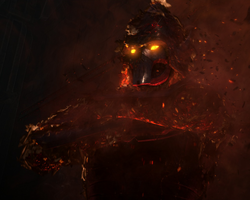
Darth Bane was an ancient Sith Lord who created the Rule of Two centuries before the Clone Wars.
The history of the galaxy has unraveled for untold millennia. The development of civilizations in all of its regions was not only influenced by physical geography, but also by urban geography and architecture, as inhabitants sought to put their own stamp on the worlds in which they inhabited.[1]
Due to the unimaginably large distances between systems, spacecraft utilized a propulsion system known as a hyperdrive to travel through hyperspace, an alternate dimension where a starship could take advantage of the wrinkles in the fabric of realspace to reduce journey time significantly, effectively "jumping" from point to point without having to travel directly between them.[9]
Approximately ten millennia before the Battle of Yavin, one or more ancestor species discovered the hyperdrive, which opened the galaxy up for exploration and travel.[7] Some like Hera Syndulla believed that the space-faring purrgils inspired sentient beings to develop the hyperdrive and travel the stars.[20]
The Jedi Order, a noble order of protectors unified by their ability to harness the power of the Force,[21] was founded over five thousand years before the Battle of Yavin.[7] According to Obi-Wan Kenobi, the Jedi served as the guardians of peace and justice for over a thousand generations in the Old Republic.[9] Later, a group of Force-users split from the Jedi[7] to form the Sith during the Hundred-Year Darkness.[22] In one of their wars, Malachor was devastated during the Great Scourge of Malachor, which left the battlefield littered with the petrified corpses of the Sith and Jedi combatants.[23]
The Sith eventually built a galactic-wide empire through the use of slave labor.[24][17] During their period of galactic dominance, the Sith built a shrine on Coruscant. After the Sith were driven away, the Jedi Temple was constructed over the shrine's foundations.[7] By 3966 BBY, galactic travelers were navigating hyperspace using hyperspace sextants.[16]
Roughly a millennium before the Battle of Yavin, the Sith were defeated by the Jedi and driven into hiding.[7] However, the Sith Lord Darth Bane survived and instituted the Rule of Two; passing the Sith legacy down to his apprentice.[25] While the Old Republic collapsed, members of House Vizsla recovered the darksaber from the Jedi Temple[26] and used it to rally and unify the Mandalorians.[27] The Jedi also defeated the Zygerrian Slave Empire.[28]
Galactic Republic
- "The Republic is not what it once was. The Senate is full of greedy, squabbling delegates. There is no interest in the common good."
- ―Sheev Palpatine
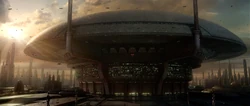
For a thousand years the Senate of the Galactic Republic governed the galaxy from its headquarters on Coruscant.
A thousand years before the outbreak of the Clone Wars, several star systems united to form the Galactic Republic, which was based on the planet Coruscant. As the home of the Galactic Senate, Coruscant would become the political capital of the galaxy. The Republic would become the dominant galactic government until the Separatist Crisis[3] With the establishment of the Republic, the Core Worlds underwent a wave of expansion by settling new worlds and establishing trading colonies. In the process, they also cut deals with native populations or simply overran them.[7] In 1019 BBY, the Yavin Code was established during the Yavin Convention to govern the treatment of prisoners.[29]
In the years leading up to the Clone Wars, the Jedi Master Sifo-Dyas foresaw an upcoming conflict and, against the wishes of the Jedi Order, commissioned the Kaminoans to create a Clone army on Kamino.[3] By 32 BBY, a dispute between the Galactic Republic and the Trade Federation over the taxation of trade routes to outlying systems had led the Federation to impose a blockade on the Mid Rim world of Naboo. The Federation was eventually expelled by a coalition of Naboo humans, Gungans, and the Jedi. Senator Sheev Palpatine of Naboo took advantage of the occupation of his homeworld in order to succeed Finis Valorum as Supreme Chancellor.[30] In secret, Palpatine was the Sith Lord Darth Sidious, who was dedicated to establishing Sith rule over the galaxy.[31]
The Clone Wars
- "The shroud of the dark side has fallen. Begun, the Clone War has."
- ―Yoda
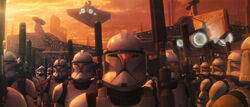
The creation of the Republic clone troopers would herald the dawn of the first pan-galactic war in a thousand years.
By 22 BBY, dissatisfaction with the Galactic Republic had led to the emergence of a Secessionist movement led by the former Jedi Count Dooku; who was secretly Darth Sidious' apprentice Darth Tyranus. During the Separatist Crisis, several thousand star systems and corporations declared their intention to leave the Republic. The discovery of a Clone army on Kamino and a Separatist Droid Army on Geonosis set the stage for the Battle of Geonosis, which became the catalyst of the Clone Wars. At the urging of Junior Representative Jar Jar Binks, the Senate transferred emergency powers to Palpatine; who used his new-found powers to formally create the Grand Army of the Republic.[3]
The Clone Wars engulfed much of the galaxy for the next three years. Republic, Jedi, and Separatist forces fought on multiple worlds and fronts including Christophsis,[32] Ryloth,[33] Umbara,[34] Onderon,[35] Coruscant, Utapau, and Kashyyyk. The Confederacy of Independent Systems collapsed with the deaths of Dooku, General Grievous, and the Separatist Council on Mustafar. Palpatine then took the opportunity to destroy the Jedi Order and to transform the Republic into the first Galactic Empire. Emperor Palpatine also took on Anakin Skywalker as his new Sith apprentice Darth Vader.[31]
Age of the Empire
- "In order to ensure the security and continuing stability, the Republic will be reorganized into the first Galactic Empire, for a safe and secure society!"
- ―Darth Sidious
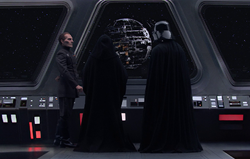
With the rise of the Galactic Empire, the galaxy was once more ruled by the Sith.
The fascist Galactic Empire became the dominant government of the galaxy for the next two and a half decades. The Empire assumed control over galactic society, economy the HoloNet, and a sprawling Imperial Military.[36] As Emperor, Palpatine wielded considerable power over the Empire's military, resources, and inhabitants. The revamped Imperial Senate saw more of its powers being transferred to planetary and regional governors who had been appointed by the Empire.[37]
The Imperial Survey Corps took an interest in exploring the uncharted reaches of space including the Unknown Regions[7] and Wild Space As a result, the demand for maps and cartographers exponentially increased. This allowed explorers such as Auric and Rhyssa Graf to make a decent living from selling maps until they were kidnapped by the Imperial Captain Visler Korda.[38] In addition, the Empire created a galactic-wide network of Imperial Academies to indoctrinate and train youths to serve in the Imperial Military.[39] In secret, the Empire embarked on an ambitious program to create a planet-destroying superweapon called the Death Star.[7]
The Empire also expropriated land and resources and ruthlessly stamped out dissent. HoloNet and other media became a propaganda medium for the Empire.[39] In addition, the Empire was also xenophobic and favored humans at the expense of alien species. In the Imperial order, aliens were regarded as serfs, slaves, and obstacles needing to be tamed, removed, or ignored. Humans came to dominate the Imperial government and military while alien species such as the Wookiees and Talz were enslaved.[40] Other alien species such as the Lasat[41] and Geonosians also experienced genocide.[42] Despite this entrenched xenophobia, some aliens rose to positions of prominence in the Empire such as Grand Vizier Mas Amedda,[7] the Pau'an Grand Inquisitor,[43] and Grand Admiral Thrawn.[44]
Eventually, dissatisfaction and opposition to the Empire culminated in a scattered network of rebel cells. Around 4 BBY, the cells became to coalesce into larger groups such as the Phoenix Cell; ending a previous policy of maintaining secrecy.[45] As the rebellion grew in power, some Imperial tacticians such as Thrawn realized that the Empire was facing a galaxy-fight insurgency.[44] By 2 BBY, these disparate rebel groups had formed an Alliance to Restore the Republic under Mon Mothma.[46] In 0 BBY, in an attempt to obtain the Death Star plans, the Rebel Alliance launched an attack on Scarif, which marked the beginning of the Galactic Civil War.[47]
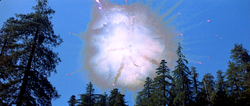
After a generation in power, the Empire sustained a major defeat at Endor, resulting in the loss of both the second Death Star and the Emperor.
Shortly later, the Empire destroyed the planet Alderaan to punish the Alderaanians for supporting the rebellion. In response, the Rebel Alliance used the stolen Death Star plans to destroy the Death Star during the Battle of Yavin.[9] For the next four years, the galaxy was locked into a civil war between the Empire and the Rebel Alliance. Fighting took place in the Mid Rim, Sullust,[6] Hoth, and Cloud City.[48] In response, the Emperor commissioned the construction of a second Death Star above Endor and laid a trap for the Rebel Alliance in a calculated gamble. However, Luke Skywalker managed to redeem his father Darth Vader, who killed the Emperor and restored balance to the Force.[49] The death of the Emperor and the destruction of the second Star had a cataclysmic effect on the galaxy.[50]
New Republic
- "Join us in the foundation of a new Republic to be shaped by the will of the governed. Claim your freedom and your future. Help is on the way."
- ―Leia Organa
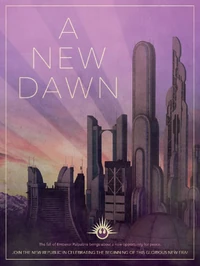
After the Battle of Endor, the New Republic was formed to mark the beginning of a new chapter in galactic history.
Following the Battle of Endor, the Rebel Alliance transitioned into the New Republic. The Galactic Civil War reached a new crescendo as the New Republic made numerous advances on multiple fronts against the bewildered remnants of the Empire.[50] The Alliance and New Republic foiled Operation: Cinder, a posthumous contingency plan by the Emperor to devastate Naboo and at least a dozen other worlds.[51][52] In the months after the events at Endor, New Republic and Imperial forces clashed on numerous fronts including the Anoat sector,[14] Malastare, Geonosis, Naalol, Sevarcos, and Akiva.[50] A civil war also broke out on the galactic capital of Coruscant.[40]
By 5 ABY, the New Republic had reconstituted the Galactic Senate on Chandrila and gained control of the HoloNet and large swaths of the galaxy including Akiva and Kuat. Han Solo, Chewbacca, and a team of Wookiee exiles and other allies also liberated the Wookiee homeworld of Kashyyyk from Imperial rule. However, the chaos caused by the Civil War and the death of the Hutt crime lord Jabba Desilijic Tiure allowed various criminal factions including the pirate lord Eleodie Maracavanya and the Red Key Raiders to gain traction. A string of Imperial defeats led Grand Admiral Rae Sloane to propose peace talks with Chancellor Mon Mothma. However, the attack on Chandrila destroyed the mood for diplomacy and enabled Fleet Admiral Gallius Rax to seize power.[40]
Proclaiming himself Counselor to the Empire, Rax brought most of the Imperial remnants to the desert world of Jakku for a showdown with the New Republic. In truth, Rax planned to execute the final stage of the Emperor's posthumous Contingency plan which involved exploding the planet Jakku in order to destroy what remained of Empire. Rax planned to lead a worthy remnant into the Unknown Regions to build a new order. Several months later, New Republic agents discovered Rax's forces and the Senate dispatched a fleet to Jakku. Amidst the fighting, Sloane joined forces with the New Republic agents Norra and Brentin Lore Wexley to foil Rax's plans. Meanwhile, Mas Amedda escaped house arrest and signed the Galactic Concordance with Chancellor Mothma, facilitating the Empire's surrender to the New Republic. While the New Republic celebrated its victory, Sloane and other loyal Imperial forces fled into the Unknown Regions.[17]
Following the Battle of Jakku, the defeated remnants of the Empire signed the Galactic Concordance, which imposed harsh war reparations and demilitarized the galaxy. With the Empire defeated, the New Republic turned its attention to reshaping the galactic order. Under New Republic rule, the galaxy endured peace for the next twenty-nine years. The remnants of the Empire eventually reforged themselves as the First Order, a militaristic junta dedicated to overthrowing the Republic. The First Order retreated to the Unknown Regions where they rebuilt their military forces and built the Starkiller Base in anticipation for their war to retake the galaxy.[16]
By 28 ABY, the New Republic was weakened by infighting between two powerful factions: the Populists, who sought greater autonomy; and the Centrists, who desired a stronger central government. The New Republic's inability to enforce financial regulations and patrol the galactic shipping lanes allowed criminal factions such as Rinnrivin Di's cartel and the Amaxine warriors to emerge. In secret, these were front organizations that had been created by the First Order to generate revenue for its rearmament program and to subvert the New Republic. With the New Republic leadership unwilling to take action against threats to its existence, Princess Leia Organa founded a paramilitary outfit called the Resistance.[53]
Rise of the First Order
- "Today is the end of the Republic! The end of a regime that acquiesces to disorder! At this very moment, in a system far from here the New Republic lies to the galaxy while secretly supporting the treachery of the loathsome Resistance. This fierce machine which you have built, upon which we stand, will bring an end to the Senate! To their cherished fleet! All remaining systems will bow to the First Order! And will remember this as the last day of the Republic!"
- ―Armitage Hux
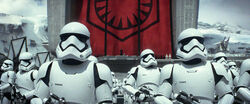
The fall of the Galactic Empire paved the way for the rise of the First Order, a military junta dedicated to reclaiming the Imperial legacy.
By 34 ABY, the Trans-Hydian Borderlands had become a buffer zone between the New Republic and the expanding First Order. Unwilling to risk conflict with the Order, the Republic ordered its military to avoid hostilities with any of it forces.[54] After failing to stop the Resistance droid BB-8, the scavenger Rey, the former stormtrooper Finn, and Solo from escaping with a map leading to Skywalker, the First Order used the superweapon Starkiller Base to launch a preemptive attack on the New Republic capital of Hosnian Prime.[55] The Hosnian Cataclysm was witnessed across the galaxy since the First Order had discovered a way of firing dark energy through sub-hyperspace within minutes.[56] In response, the Resistance destroyed Starkiller Base.[55]
Despite the destruction of Starkiller Base, the Hosnian Cataclysm dealt a serious blow to the New Republic with General Armitage Hux predicting that the New Republic's core systems would fall to the First Order within weeks. The First Order also launched an offensive against the Resistance, destroying their base on D'Qar and pursuing them through space with a hyperspace tracker. Though the First Order inflicted heavy casualties on the Resistance, the First Order also sustained serious losses when Vice Admiral Amilyn Holdo rammed the Resistance's flagship Raddus into Supreme Leader Snoke's flagship Supremacy. Snoke himself was assassinated by his apprentice Kylo Ren, who claimed the title of Supreme Leader. Ren pursued the surviving members of the Resistance to the planet Crait. There, Luke Skywalker made his last stand which gave the Resistance and the last Jedi Rey enough time to escape aboard the Millennium Falcon. The survival of the Resistance ensured that the First Order's war to conquer the galaxy would be met by staunch resistance.[57]
Appearances
The galaxy appears in literally every single piece of Star Wars media. This list only includes specific mentions, descriptions, and visual representations of the galaxy.
Non-canon appearances
- Revenge of the Sith: Episode III (LEGO Star Wars)
